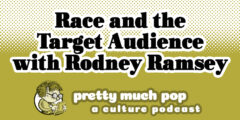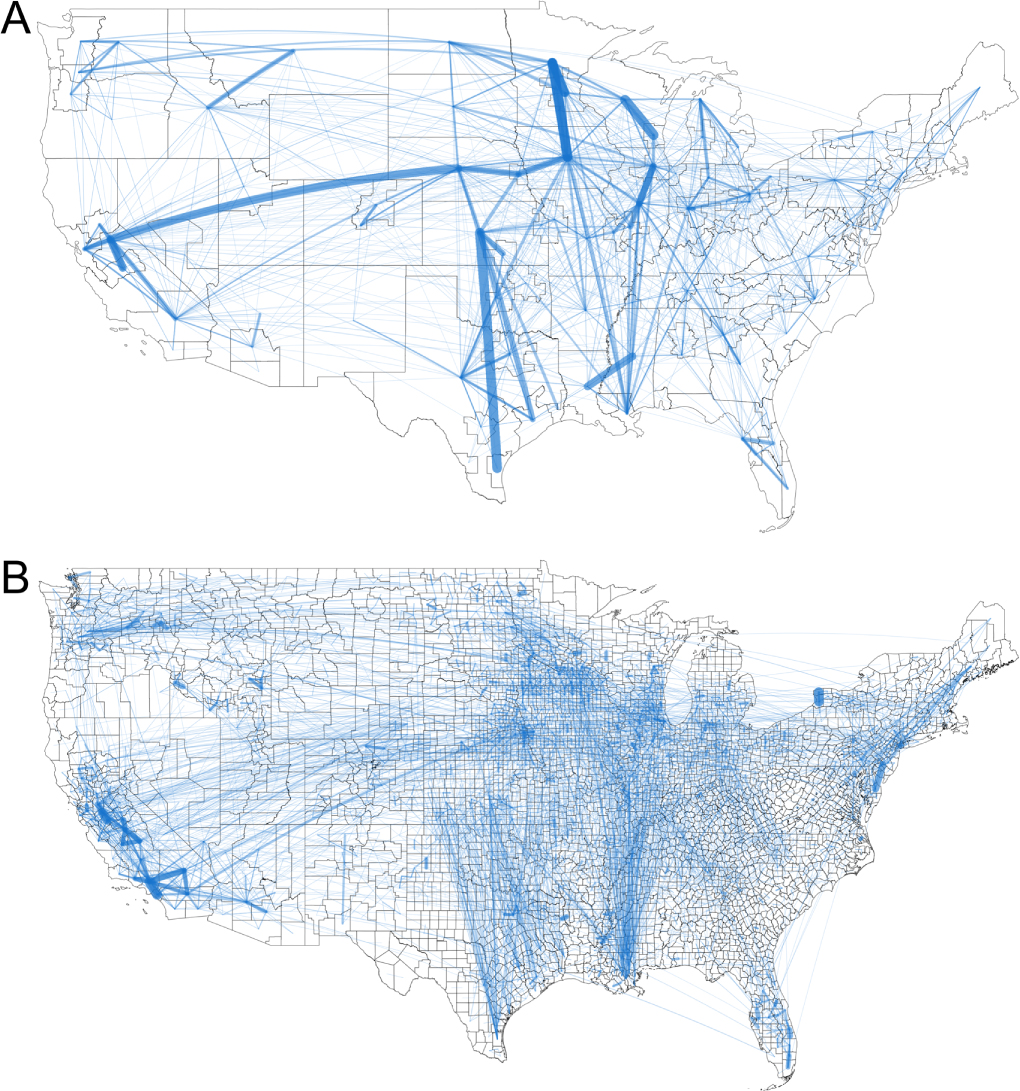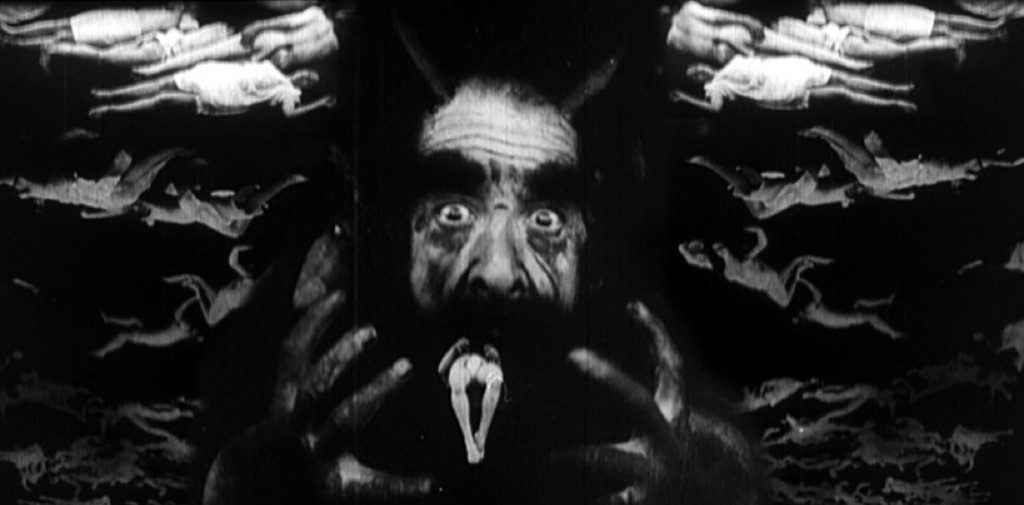[Most Recent Entries] [Calendar View]
Thursday, November 14th, 2019
- “What Does It Mean to ‘Sound’ Black?” by Hannah Giorgis
- “A Racial Divide Widens on Network TV” by James Strerngold (in 1998!)
- “Why White People Don’t Like Black Movies” by Andre Seewood (2014)
- “Moving Beyond Audience Segmentation: What Marketers Can Learn from Post-Demographic Consumerism” by Lauren McMenemy
| Time | Event |
| 8:01a | Pretty Much Pop #19 Discusses Race and the Target Audience w/ Rodney Ramsey 
We’ve all felt at various points (maybe at most points) that some media creation has reached us by mistake, that we are not the target audience. 20th century American TV was aimed largely at a white majority, with a parallel, underfunded channel of content aimed at people of color. So how have things changed? There still seem to be “black shows,” but how to they fit in to a landscape where inclusiveness is a tool by which shows attempt to appeal to everyone (i.e. get all the money)? Comedian/actor/writer/producer Rodney Ramsey joins Mark, Erica, and Brian to discuss the experience of watching outside your demographic, whether identifying with characters requires physical commonalities, “black voice,” and the evolving TV landscape. We touch on Watchmen, Atlanta, Black Panther, Insecure, Sorry to Bother You, BlacKkKlansman, Tyler Perry, Dear White People, Black Jesus, and the black Herminone issue. Some of the articles we considered included: Follow Rodney @Rodney_Ramsey. This episode includes bonus discussion that you can only hear by supporting the podcast at patreon.com/prettymuchpop. This podcast is part of the Partially Examined Life podcast network. Pretty Much Pop: A Culture Podcast is the first podcast curated by Open Culture. Browse all Pretty Much Pop posts or start with the first episode. Pretty Much Pop #19 Discusses Race and the Target Audience w/ Rodney Ramsey is a post from: Open Culture. Follow us on Facebook, Twitter, and Google Plus, or get our Daily Email. And don't miss our big collections of Free Online Courses, Free Online Movies, Free eBooks, Free Audio Books, Free Foreign Language Lessons, and MOOCs. |
| 9:00a | The First High-Resolution Map of America’s Food Supply Chain: How It All Really Gets from Farm to Table
The phrase "farm to table" has enjoyed vogue status in American dining long enough to be facing displacement by an even trendier successor, "farm to fork." These labels reflect a new awareness — or an aspiration to awareness — of where, exactly, the food Americans eat comes from. A vast and fertile land, the United States produces a great deal of its own food, but given the distance of most of its population centers from most of its agricultural centers, it also has to move nearly as great a deal of food over long domestic distances. Here we have the very first high-resolution map of that food supply chain, created by researchers at the University of Illinois studying "food flows between counties in the United States." "Our map is a comprehensive snapshot of all food flows between counties in the U.S. – grains, fruits and vegetables, animal feed, and processed food items," writes Assistant Professor of Civil and Environmental Engineering Megan Konar in an explanatory post at The Conversation. (The top version shows the total tons of food moved, and the bottom one is broken down to the county scale.) "All Americans, from urban to rural are connected through the food system. Consumers all rely on distant producers; agricultural processing plants; food storage like grain silos and grocery stores; and food transportation systems." The map visualizes such journeys as that of a shipment of corn, which "starts at a farm in Illinois, travels to a grain elevator in Iowa before heading to a feedlot in Kansas, and then travels in animal products being sent to grocery stores in Chicago." Konar and her collaborators' research arrives at a few surprising conclusions, such as that Los Angeles county is both the largest shipper and receiver of food in the U.S. Not only that, but almost all of the nine counties "most central to the overall structure of the food supply network" are in California. This may surprise anyone who has laid eyes on the sublimely huge agricultural landscapes of the Midwest "Cornbelt." But as Konar notes, "Our estimates are for 2012, an extreme drought year in the Cornbelt. So, in another year, the network may look different." And of the grain produced in the Midwest, much "is transported to the Port of New Orleans for export. This primarily occurs via the waterways of the Ohio and Mississippi Rivers." Konar also warns of troubling frailties: "The infrastructure along these waterways—such as locks 52 and 53—are critical, but have not been overhauled since their construction in 1929," and if they were to fail, "commodity transport and supply chains would be completely disrupted." The analytical minds at Hacker News have been discussing the implications of the research shown on this map, including whether the U.S. food supply chain is really, as one commenter put it, "very brittle and contains many weak points." The American Society of Civil Engineers, as Konar tells Food & Wine, has given the country's civil engineering infrastructure a grade of D+, which at least implies considerable room for improvement. But against what from some angles look like long odds, food keeps getting from American farms to American tables — and American forks, American mouths, American stomachs, and so on. Related Content: Download 91,000 Historic Maps from the Massive David Rumsey Map Collection View and Download Nearly 60,000 Maps from the U.S. Geological Survey (USGS) Based in Seoul, Colin Marshall writes and broadcasts on cities, language, and culture. His projects include the book The Stateless City: a Walk through 21st-Century Los Angeles and the video series The City in Cinema. Follow him on Twitter at @colinmarshall or on Facebook. The First High-Resolution Map of America’s Food Supply Chain: How It All Really Gets from Farm to Table is a post from: Open Culture. Follow us on Facebook, Twitter, and Google Plus, or get our Daily Email. And don't miss our big collections of Free Online Courses, Free Online Movies, Free eBooks, Free Audio Books, Free Foreign Language Lessons, and MOOCs. |
| 12:00p | The Velvet Underground as Peanuts Characters: Snoopy Morphs Into Lou Reed, Charlie Brown Into Andy Warhol The fun cartoon above was apparently found in a "Guide to the Velvet Underground and Andy Warhol's Factory" published by the French magazine, Les Inrockuptibles in 1990. It came around the same time the Fondation Cartier pour l'art contemporain (located in Paris) held an exhibition dedicated to Andy Warhol. Of course, Warhol famously took a break from painting in the mid-1960s and, among other things, threw his influence behind the up-and-coming NYC band, The Velvet Underground. Serving as the band's manager, he "produced" VU's first album, which meant designing the album cover and giving the band members -- Lou Reed, John Cale, Sterling Morrison, Maureen Tucker and Nico -- the freedom to make whatever album they pleased, up to a certain point. Above, you can see these same musicians reimagined as Peanuts characters. Would you like to support the mission of Open Culture? Please consider making a donation to our site. It's hard to rely 100% on ads, and your contributions will help us continue providing the best free cultural and educational materials to learners everywhere. Also consider following Open Culture on Facebook and Twitter and sharing intelligent media with your friends. Or sign up for our daily email and get a daily dose of Open Culture in your inbox. Related Content: The Velvet Underground Captured in Color Concert Footage by Andy Warhol (1967) A Symphony of Sound (1966): Velvet Underground Improvises, Warhol Films It, Until the Cops Turn Up The Velvet Underground as Peanuts Characters: Snoopy Morphs Into Lou Reed, Charlie Brown Into Andy Warhol is a post from: Open Culture. Follow us on Facebook, Twitter, and Google Plus, or get our Daily Email. And don't miss our big collections of Free Online Courses, Free Online Movies, Free eBooks, Free Audio Books, Free Foreign Language Lessons, and MOOCs. |
| 3:00p | Watch L’Inferno (1911), Italy’s First Feature Film and Perhaps the Best Adaptation of Dante’s Classic In its second decade, cinema struggled to evolve. The first films by the Lumière Brothers and Thomas Edison were short and gimmicky - shots of trains racing towards the screen, couples kissing and cute kittens getting fed. A quick rush. A bit of fun. Its creators didn’t see much past the novelty of cinema but then other filmmakers like Georges Méliès, Edwin S Porter, Alice Guy-Blaché and D.W. Griffith started injecting this new medium with elements of story. It started aspiring towards art. To this end, filmmakers started to expand the canvas on which they created. Films that were just two to eight minutes lengthened in duration as their stories grew in complexity. The first feature-length movie came in 1906 with the Australian movie The Story of the Kelly Gang. In 1915, D.W. Griffith premiered his racist masterpiece The Birth of a Nation, which crystallized film language and proved that longer movies could be financially successful. In between those two movies came L’Inferno (1911) – perhaps the finest cinematic adaptation of Dante's Inferno out there and the first feature-length Italian movie ever. Like Griffith, the makers of L’Inferno - Francesco Bertolini, Adolfo Padovan and Giuseppe de Liguoro – sought to raise cinema to the ranks of literature and theater. Unlike Griffith, they didn’t really do much to forward the language of cinema. Throughout L’Inferno, the camera remains wide and locked down like the proscenium of a stage. Instead, they focused their efforts on creating gloriously baroque sets and costumes. Much of the film looks like it was pulled straight from Gustave Dorè’s famed illustrations of The Divine Comedy. Yet seeing a picture in a book of a demon is one thing. Seeing it leap around lashing the naked backs of the damned is something else entirely. If you were ever tempted by the sin of simony, you’ll think twice after seeing this film. L’Inferno -- now added to our collection of Free Movies Online -- became both a critical and commercial hit worldwide, raking in over $2 million (roughly $48 million in today’s money) in the US alone. “We have never seen anything more precious and fine than those pictures. Images of hell appear in all their greatness and power,” gushed famed Italian novelist and reporter Matilde Serao when the film came out. American film critic for The Moving Picture World, W. Stephen Bush, was even more effusive:
Of course, the film’s combination of ghoulishness and nudity made it ripe to be co-opted by shady producers who had less that lofty motives. Scenes from L’Inferno were cut into such exploitation flicks as Hell-O-Vision (1936) and Go Down, Death! (1944). You can watch the full movie above. Be sure to watch to the end where Satan himself can be seen devouring Brutus and Cassius. Note: An earlier version of this post appeared on our site in July 2015. Related Content: Visualizing Dante’s Hell: See Maps & Drawings of Dante’s Inferno from the Renaissance Through Today Artists Illustrate Dante’s Divine Comedy Through the Ages: Doré, Blake, Botticelli, Mœbius & More A Digital Archive of the Earliest Illustrated Editions of Dante’s Divine Comedy (1487-1568) Alberto Martini’s Haunting Illustrations of Dante’s Divine Comedy (1901-1944) Gustave Doré’s Dramatic Illustrations of Dante’s Divine Comedy Jonathan Crow is a Los Angeles-based writer and filmmaker whose work has appeared in Yahoo!, The Hollywood Reporter, and other publications. You can follow him at @jonccrow. And check out his blog Veeptopus, featuring lots of pictures of vice presidents with octopuses on their heads. The Veeptopus store is here. Watch L’Inferno (1911), Italy’s First Feature Film and Perhaps the Best Adaptation of Dante’s Classic is a post from: Open Culture. Follow us on Facebook, Twitter, and Google Plus, or get our Daily Email. And don't miss our big collections of Free Online Courses, Free Online Movies, Free eBooks, Free Audio Books, Free Foreign Language Lessons, and MOOCs. |
| 7:32p | How Humans Migrated Across The Globe Over 200,000 Years: An Animated Look Coverage of the refugee crisis peaked in 2015. By the end of the year, note researchers at the University of Bergen, “this was one of the hottest topics, not only for politicians, but for participants in the public debate,” including far-right xenophobes given megaphones. Whatever their intent, Daniel Trilling argues at The Guardian, the explosion of refugee stories had the effect of framing “these newly arrived people as others, people from ‘over there,’ who had little to do with Europe itself and were strangers.” Such a characterization ignores the crucial context of Europe’s presence in nearly every part of the world over the past several centuries. And it frames mass migration as extraordinary, not the norm. The crisis aspect is real, the result of dangerously accelerated movement of capital and climate change. But mass movements of people seeking better conditions, safety, opportunity, etc. may be the oldest and most common feature of human history, as the Science Insider video shows above. The yellow arrows that fly across the globe in the dramatic animation make it seem like early humans moved by bullet train. But when consequential shifts in climate occurred at a glacial pace—and economies were built on what people carried on their backs—mass migrations happened over the span of thousands of years. Yet they happened continuously throughout last 200,000 to 70,000 years of human history, give or take. We may never know what drove so many of our distant ancestors to spread around the world. But how can we know what routes they took to get there? “Thanks to the amazing work of anthologists and paleontologists like those working on National Geographic’s Genographic Project,” Science Insider explains, “we can begin to piece together the story of our ancestors.” The Genographic Project was launched by National Geographic in 2005, “in collaboration with scientists and universities around the world.” Since then, it has collected the genetic data of over 1 million people, “with a goal of revealing patterns of human migration.” The project assures us it is “anonymous, nonmedical, and nonprofit.” Participants submitted their own DNA with National Geographic’s “Geno” ancestry kits (and may still do so until next month). They can receive a “deep ancestry” report and customized migration map; and they can learn how closely they are related to “historical geniuses,” a category that, for some reason, includes Jesse James. Do projects like these veer close to recreating the “race science” of previous centuries? Are they valid ways of reconstructing the “human story” of ancestry, as National Geographic puts it? Critics like science journalist Angela Saini are skeptical. “DNA testing cannot tell you that,” she says in an interview on NPR, but it can “make us believe that identity is biological, when identity is cultural.” National Geographic seems to disavow associations between genetics and race, writing, “science defines you by your DNA, society defines you by the color of your skin.” But it does so at the end of a video about a group of people bonding over their similar features. Despite the significance modern humans have ascribed to variations in phenotype, race is a culturally defined category and not a scientific one. argues Joseph L. Graves, professor of biological sciences at the Joint School of Nanoscience and Nanoengineering.. "Everything we know about our genetics has proven that we are far more alike than we are different. If more people understood that, it would be easier to debunk the myth that people of a certain race are ‘naturally’ one way or another,” or that refugees and asylum seekers are dangerous others instead of just like every other human who has moved around the world over the last 200,000 years. Related Content: Colorful Animation Visualizes 200 Years of Immigration to the U.S. (1820-Present) Where Did Human Beings Come From? 7 Million Years of Human Evolution Visualized in Six Minutes Ian McKellen Reads a Passionate Speech by William Shakespeare, Written in Defense of Immigrants Josh Jones is a writer and musician based in Durham, NC. Follow him at @jdmagness How Humans Migrated Across The Globe Over 200,000 Years: An Animated Look is a post from: Open Culture. Follow us on Facebook, Twitter, and Google Plus, or get our Daily Email. And don't miss our big collections of Free Online Courses, Free Online Movies, Free eBooks, Free Audio Books, Free Foreign Language Lessons, and MOOCs. |
| << Previous Day |
2019/11/14 [Calendar] |
Next Day >> |





